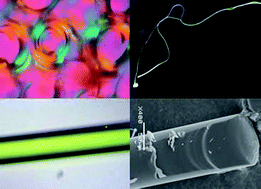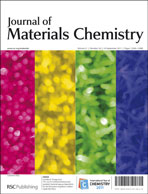Design and synthesis of photoactive ionic amorphous molecular materials†
Abstract
Compounds bearing electrostatic charges have unique properties including outstanding ionic-conductivity when compared with neutral ones. On the other hand, amorphous molecular materials harness the advantages of small molecules with high purity, defined structures and monodispersity, while still being easily processable into thin films and fibers. Here, we report a series of bis(pyridinium salt)s that combine these properties to form ionic amorphous molecular materials. Their design allowed them to vitrify efficiently upon slow cooling. They exhibited glass-transition temperatures in the range of 81–191 °C and had excellent thermal stabilities of up to 461 °C. Fibers were easily drawn from their melts that were visible to the naked eye. Although they were completely conjugated and had large molecular sizes, they were soluble in many common organic


 Please wait while we load your content...
Please wait while we load your content...